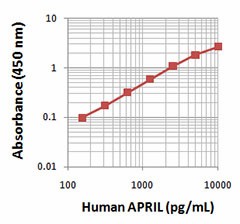- Regulatory Status
- RUO
- Other Names
- A Proliferation Inducing Ligand (APRIL), TNFSF13, CD256, TALL2, TRDL1
- Ave. Rating
- Submit a Review
- Product Citations
- publications

| Cat # | Size | Price | Quantity Check Availability | Save | ||
|---|---|---|---|---|---|---|
| 591309 | 4 pack | 94 CHF | ||||
This product is not available for shipping outside of the United States.
APRIL (A Proliferation-Inducing Ligand), also known as TNFSF13, stimulates cell proliferation. It is a member of the TNF superfamily of ligands, being most closely related to BAFF, with which it shares 30% amino acid sequence identity. APRIL is cleaved intracellularly by furin and is believed to exist mainly in a secreted, soluble form. As with most other TNF family members, APRIL exists as a functional homotrimer (total MW = 90 kD). It can bind to two cell-surface receptors: BCMA and TACI, which it shares with BAFF, to exert downstream T- and B-cell regulatory effects. It also possesses a heparin binding domain and has been demonstrated to bind to proteoglycans on the cell surface.
APRIL is most well known for its tumor proliferation effects. It is a potential biomarker, with serum levels elevated for certain cancers and expression levels elevated in cancer tissues. It is also a potential biomarker for certain autoimmune diseases. In fact, recombinant TACI has been brought to clinical trials as a neutralization drug against APRIL and BAFF for the treatment of systemic lupus erythematosus (SLE).
Besides forming homotrimers, APRIL can also form functional heterotrimers with BAFF. The stoichiometric relationship of the protomeric units is still unclear; however, it appears that these heterotrimers are significant in that they are elevated in the serum of certain autoimmune patients.
APRIL also forms an endogenous chimeric protein with another related protein, TWEAK, effectively called TWE-PRIL. It is believed that TWE-PRIL is membrane bound, and consists of the N-terminus of TWEAK with its transmembrane domain, and the C-terminus of APRIL with its receptor binding domain.
Product Details
- Source
- Human APRIL, Ala 105 - Leu 250 (Accession# O75888), was expressed in HEK-293 cells with N-terminal tags.
- Molecular Mass
- The recombinant protein has a predicted molecular weight of 21.7 kD. The DTT-reduced protein migrates at approximately 26 kD by SDS-PAGE.
- Purity
- Purity is >90% as determined by SDS-PAGE under reducing conditions, stained with silver stain.
- Formulation
- Lyophilized in sterile-filtered PBS, pH 7.2, containing 1% BSA, 0.09% sodium azide, and protease inhibitors.
- Concentration
- Lot-specific (to obtain lot-specific concentration and expiration, please enter the lot number in our Certificate of Analysis online tool.)
- Storage & Handling
- Unopened vials can be stored between 2°C and 8°C until the expiration date. Prior to use, reconstitute the lyophilized powder with 0.2 mL of PBS containing a carrier protein (e.g., 1% BSA, protease free), pH7.4. Re-cap vial, vortex. Allow the reconstituted standard to sit at room temperature for 15 minutes, vortex again to mix completely. The reconstituted standard stock solution can be aliquoted into polypropylene vials and stored at -70°C for up to one month. Do not re-use diluted standards. Avoid repeated freeze/thaw cycles.
- Application
-
ELISA - Quality tested
- Recommended Usage
-
For use as a sandwich ELISA standard, a standard curve comprised of two-fold dilutions from 10 ng/ml to 0.16 ng/ml is recommended when used in conjunction with purified 33H5 (Cat. No. 524802) as the capture antibody, and biotinylated 53E11 (Cat. No. 524904) as the detection antibody. It is recommended that the reagent be titrated for optimal performance for each application.
Antigen Details
- Structure
- Transmembrane protein of 26 kD, forms a homotrimer that is cleaved from the cell surface resulting in the soluble form of APRIL; forms heterotrimers with BLyS (BAFF)
- Distribution
-
T cells, B cells, dendritic cells, monocytes, and macrophages
- Function
- Induces proliferation of T and B cells, promotes IgA class switching and downregulates T-cell dependent antibody responses, regulates the growth of a variety of tumor cells
- Ligand/Receptor
- TNFRSF13b (TACI), TNFRSF17 (BCMA)
- Biology Area
- Apoptosis/Tumor Suppressors/Cell Death, Cell Biology, Signal Transduction
- Molecular Family
- Cytokines/Chemokines
- Antigen References
-
1. Hymowitz, S, et al. 2005. J. Biol. Chem. 280:7218.
2. Ingold K, et al. 2005. J. Exp. Med. 201:1375.
3. Good K, et al. 2009. J. Immunol. 182:890.
4. Bossen C, et al. 2008. Blood 111:1004.
5. Bossen C, et al. 2006. J. Biol. Chem. 281:13964.
6. Pradet-Balade B, et al. 2002. EMBO J. 21:5711.
7. Hahne M, et al. 1998. J. Exp. Med. 188:1185.
8. Medema JP, et al. 2003. Cell Death Differ. 10:1121.
9. Planelles L, et al. 2007. Haematologica. 92:1284.
10. Dillon SR, et al. 2010. Arthritis Res. Ther 12:R48.
11. Wallweber H, et al. 2004. J. Mol. Biol. 343:283.
12. Chen Y, et al. 2011. PLoS ONE 6:e22202.
13. Roschke V, et al. 2002. J. Immunol. 169:4314. - Gene ID
- 8741 View all products for this Gene ID
- UniProt
- View information about APRIL on UniProt.org
 Login / Register
Login / Register 
















Follow Us